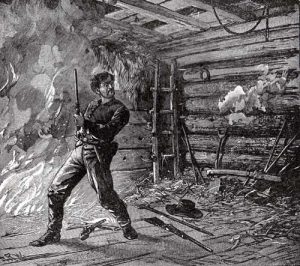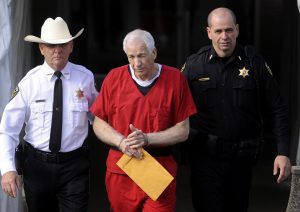As reporters and health officials walked onto the grounds of the mass suicide in Guayana, they were in shock over what they were seeing; hundreds of bodies face down on the ground, dead. One person who was at the site said that the amount of dead bodies was appalling, “it was depicted as not American, not religious, not sane, and ultimately not human.”1 Over 550 bodies of the 900 were unclaimed for almost six months until US Officials decided to cremate them. Once they brought the bodies back to the United States from Guayana, many Americans didn’t think it was right to have these bodies spread out on American soil because of the act they made. US Officials then decided to scatter the ashes of the dead bodies away from the United States border lines.

It all started with Jim Jones. Jones was a religious/political cult leader who had established the People’s Temple as a sect in Indianapolis in the 1950s. His cult focused on themes of communism, and the fight against racism, attracting many African Americans. He moved his cult to San Francisco in 1971, but it would not remain there for long. Soon after the group moved there, Jones was accused of financial fraud, physical abuse of his cult’s members, and mistreatment of children. After Jones was accused, in 1973, he became paranoid that someone would try to destroy his cult, so he moved his entire group to Guayana, South America, to build a socialist utopia known as Jonestown.

Once the cult moved to Guayana, people started to question even more the accusations being made against Jim Jones. Members who had left or escaped the cult were worried for the people still in the cult, so they convinced U.S. Congressmen Leo Ryan of California to fly to Guyana. “In November 1978, Ryan along with a group of journalists and relatives of cult members went to investigate the charges.”2 Jones did not like the idea of people coming to investigate, so he ordered his followers to have Ryan and his investigators assassinated. He ordered the attack on the group as they were returning to the airstrip to leave. A journalist named Charles Krause reported that that morning Ryan was attacked by a man with a knife, although he was not hurt by the incident. “Later that same day, Ryan and his party were attacked by assassins at the Port Kaituma Airstrip. Ryan and four others were killed and ten were injured.”3 While these killings were going on, Jones feared that he would lose his cult members and they would turn against him. He then proceeded to lead his people through a mass suicide, which was something the members had repeatedly practiced since the early 1970s.
These practices were called “White Nights” and consisted of members drinking a liquid that they believed was poisonous as a loyalty test to Jones.4 During these “White Nights,” people were woken up by a loud speaker, and they would assemble for the ritual of passing around a drink of kool-aid, which they were told was poison. Unfortunately, this time was not a test. Hundreds of adults and children lined up to drink this colorful, fruit-flavored punch, which contained cyanide and tranquilizers. Most of them thought they were just proving their loyalty as before, but as more people began to die, they realized that this time it was real. “Over 260 children, for example, had the poison given to them, while only about 40 adults escaped.”5 For those who died willingly though, collective suicide held a religious significance in the context of the worldview that had been established in Jonestown.

Collective suicide was a ritual that signified a purity of commitment to the community. On the night that they all drank this poison, Jim Jones announced “that the members of the community were united as black, proud socialists.”6 Collective suicide also promised release from a world dominated by what Jones perceived as American racism, capitalism, and fascism. He did not want to be captured and taken back to America, so instead he urged his followers to drink the poison, and “step out of the world.”7 Jones had told his followers that they were not committing suicide, but rather they were performing an act of freeing themselves from the harsh world that they lived in. There are later reports that when officials went to Jonestown, Jim Jones was found with gunshot wounds, raising the speculation that either he had committed suicide or someone else had killed him.
The Jonestown Massacre was the largest mass suicide in modern history and resulted in the largest single loss of American civilian life in a non-natural disaster until the September 11 attack in 2001. The mass suicide resulted in over 900 deaths of innocent lives. Once the bodies were found, the Guyanese government asked the United States to take the bodies back. US Officials decided to start sending a few people over to identify bodies so they could decide what to do with them. Over 500 bodies were unclaimed and that is when the United States decided to have the US Air Force come in to take the bodies back to the United States.”8 To this day, families of loved ones are still trying to find a memorial place for the lost lives.
- Encyclopedia of Religion, 2005, s.v. “Jonestown and Peoples Temple,” by David Chidester. ↵
- Dictionary of American History, 2003, s.v. “Jonestown Massacre,” by Carolyn Bronstein. ↵
- Dictionary of American History, 2003, s.v. “Jonestown Massacre,” by Carolyn Bronstein. ↵
- Dictionary of American History, 2003, s.v. “Jonestown Massacre,” by Carolyn Bronstein. ↵
- Encyclopdeia of Religion, 2005, s.v. “Jonestown and Peoples Temple,” by David Chidester. ↵
- Encyclopdeia of Religion, 2005, s.v. “Jonestown and Peoples Temple,” by David Chidester. ↵
- Encyclopdeia of Religion, 2005, s.v. “Jonestown and Peoples Temple,” by David Chidester. ↵
- Encyclopdeia of Religion, 2005, s.v. “Jonestown and Peoples Temple,” by David Chidester. ↵



150 comments
Joshua Breard
There are many things that I do not like about the article. The obvious being how one man could be so diabolical to perform such actions. The other being how over 900 people actually listened to him because he was the cult leader. There are too many things wrong in this and it makes me upset that such events actually took place in history. I wish that something like that this would never happen again but I am glad that this article was written as this was my first encounter with the event.
Josselyn Arrieta-Meraz
It is truly heartbreaking and sad on what these people were put on to do, it was their way of life controlled by someone who felt and overruling of these innocent lives. Such a marking event in history that I wished didn’t exist although there’s a little of everything in this world. The people in this town were brainwashed with this ideology that proving your loyalty to a cult was shown by drinking a drink and to think that they were so loyal to where they would do it knowing something might have not been right. An truly memorable event in history.
Tyler Bradford
This is a truly intriguing article because of the crazy and messed up story it tells. I really can’t believe that one man could do such a thing like that or be capable of something that horrendous. It really makes me question if there are any others out there in the world like Jim Jones or others that think the same way as he did. I just can’t wrap my head around the fact that 900 people were really convinced enough to be willing to commit suicide for a leader, Jim Jones, who probably didn’t care for their well being at all because he was running from his own problems.
Jasmine Martinez
I still find it incredibly unbelievable that one person, Jim Jones, was able to not only convince 900 hundred of his ideas, but was able to get them to commit something as gruesome as suicide. Truly a chilling story to read but also very eye opening to those who have never heard of The Jonestown Massacre of 1978, such as myself.
Carlos Aparicio
Well written article but I can’t piece together how Jones persuaded 900 people to view him as a leader, even if the cult had focused on themes of communism, and the fight against racism. I like how this article goes into detail about who was killed, how many, and how because those are all important factors. No life should be taken for any reason especially for someone else’s fault. Well done article but was a tragic story.
Deanna Lummus
This is so interesting yet sad.. I have never heard about this and frankly I am appalled. I have heard about mass suicide through school and learning about how certain religions believe but never like this. I still don’t understand how this man got at least a thousand people to follow him and kill for him. This cult seems to be founded on hate and very low self esteemed individuals. I can only wonder how sad it was to be a child in this cult when your parents are that “put out” by their America that they would let their own children commit suicide. Instead of leaving this so called horrible world, why not stay and try to better it? Also it is so tacky to call his new utopia “Jonestown”. It sounds like “Jamestown’ which was the first colony in the United states and it just shows ignorance and disrespect.
Edith De Loera
I had initially heard about this event while in my junior year of high school, but it was a very brief lesson. I was drawn to this article because of its familiar title but found myself extremely intrigued by its story. It is absolutely unbelievable how quickly life can change up on us. I truly wonder how Jim Jones was capable of having so many people be loyal to him, and believe his word.
Liam Gillooly
What a bizarre experience. I remember reading that the leaders of Jonestown actually kept friendly relations with the White House at the time. It is incredibly sad that so many innocent people lost their lives to those mad men. But still, reading about the history of Jonestown makes me glad to be someone with a strong, non-pliable will. Thank you for this informative article!
Rolando Mata
this was a haunting article that truly moved me. although the article itself is well written I truly found the image used incredibly effective in surprising and bringing in the audience and setting the scene for the dark subject matter in the article. I have personally only ever heard of bits and pieces of this event although this article does a fantastic job of gripping and informing.
Troy Leonard
I’ve herd about the James town massacre but I didn’t know about the full extent of it. killing almost 1000 people and 550 of the bodies have not been identified is very disturbing. I could only imagine how their family member fell about no knowing if there family members were dead or alive. you did a great job at explaining the full extent of what was going on.